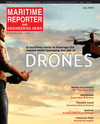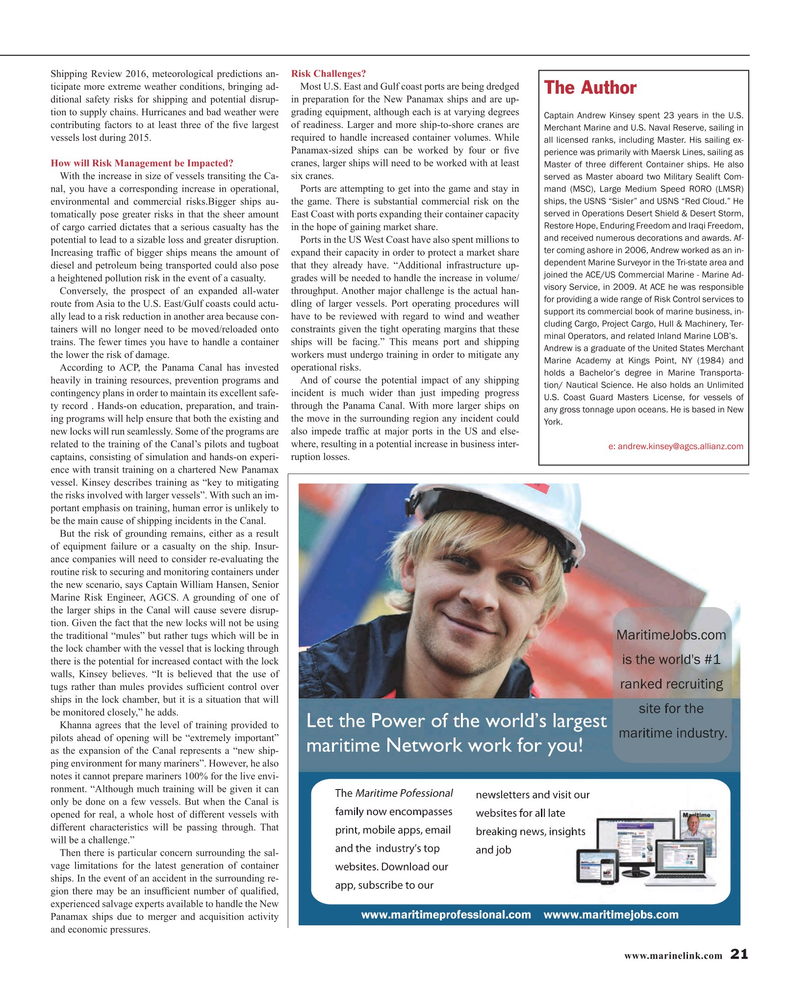
Page 21: of Maritime Reporter Magazine (July 2016)
Marine Communications Edition
Read this page in Pdf, Flash or Html5 edition of July 2016 Maritime Reporter Magazine
Shipping Review 2016, meteorological predictions an- Risk Challenges?
ticipate more extreme weather conditions, bringing ad- Most U.S. East and Gulf coast ports are being dredged
The Author ditional safety risks for shipping and potential disrup- in preparation for the New Panamax ships and are up- tion to supply chains. Hurricanes and bad weather were grading equipment, although each is at varying degrees
Captain Andrew Kinsey spent 23 years in the U.S. contributing factors to at least three of the ? ve largest of readiness. Larger and more ship-to-shore cranes are
Merchant Marine and U.S. Naval Reserve, sailing in vessels lost during 2015. required to handle increased container volumes. While all licensed ranks, including Master. His sailing ex-
Panamax-sized ships can be worked by four or ? ve perience was primarily with Maersk Lines, sailing as
How will Risk Management be Impacted? cranes, larger ships will need to be worked with at least
Master of three different Container ships. He also
With the increase in size of vessels transiting the Ca- six cranes.
served as Master aboard two Military Sealift Com- mand (MSC), Large Medium Speed RORO (LMSR) nal, you have a corresponding increase in operational, Ports are attempting to get into the game and stay in ships, the USNS “Sisler” and USNS “Red Cloud.” He environmental and commercial risks.Bigger ships au- the game. There is substantial commercial risk on the served in Operations Desert Shield & Desert Storm, tomatically pose greater risks in that the sheer amount East Coast with ports expanding their container capacity
Restore Hope, Enduring Freedom and Iraqi Freedom, of cargo carried dictates that a serious casualty has the in the hope of gaining market share. and received numerous decorations and awards. Af- potential to lead to a sizable loss and greater disruption. Ports in the US West Coast have also spent millions to ter coming ashore in 2006, Andrew worked as an in-
Increasing traf? c of bigger ships means the amount of expand their capacity in order to protect a market share dependent Marine Surveyor in the Tri-state area and diesel and petroleum being transported could also pose that they already have. “Additional infrastructure up- joined the ACE/US Commercial Marine - Marine Ad- a heightened pollution risk in the event of a casualty. grades will be needed to handle the increase in volume/ visory Service, in 2009. At ACE he was responsible
Conversely, the prospect of an expanded all-water throughput. Another major challenge is the actual han- for providing a wide range of Risk Control services to route from Asia to the U.S. East/Gulf coasts could actu- dling of larger vessels. Port operating procedures will support its commercial book of marine business, in- ally lead to a risk reduction in another area because con- have to be reviewed with regard to wind and weather cluding Cargo, Project Cargo, Hull & Machinery, Ter- tainers will no longer need to be moved/reloaded onto constraints given the tight operating margins that these minal Operators, and related Inland Marine LOB’s. trains. The fewer times you have to handle a container ships will be facing.” This means port and shipping
Andrew is a graduate of the United States Merchant the lower the risk of damage. workers must undergo training in order to mitigate any
Marine Academy at Kings Point, NY (1984) and
According to ACP, the Panama Canal has invested operational risks.
holds a Bachelor’s degree in Marine Transporta- heavily in training resources, prevention programs and And of course the potential impact of any shipping tion/ Nautical Science. He also holds an Unlimited contingency plans in order to maintain its excellent safe- incident is much wider than just impeding progress
U.S. Coast Guard Masters License, for vessels of ty record . Hands-on education, preparation, and train- through the Panama Canal. With more larger ships on any gross tonnage upon oceans. He is based in New ing programs will help ensure that both the existing and the move in the surrounding region any incident could
York. new locks will run seamlessly. Some of the programs are also impede traf? c at major ports in the US and else- related to the training of the Canal’s pilots and tugboat where, resulting in a potential increase in business inter- e: [email protected] captains, consisting of simulation and hands-on experi- ruption losses.
ence with transit training on a chartered New Panamax vessel. Kinsey describes training as “key to mitigating the risks involved with larger vessels”. With such an im- portant emphasis on training, human error is unlikely to be the main cause of shipping incidents in the Canal.
But the risk of grounding remains, either as a result of equipment failure or a casualty on the ship. Insur- ance companies will need to consider re-evaluating the routine risk to securing and monitoring containers under the new scenario, says Captain William Hansen, Senior
Marine Risk Engineer, AGCS. A grounding of one of the larger ships in the Canal will cause severe disrup- tion. Given the fact that the new locks will not be using the traditional “mules” but rather tugs which will be in the lock chamber with the vessel that is locking through there is the potential for increased contact with the lock walls, Kinsey believes. “It is believed that the use of tugs rather than mules provides suf? cient control over ships in the lock chamber, but it is a situation that will be monitored closely,” he adds.
Khanna agrees that the level of training provided to pilots ahead of opening will be “extremely important” as the expansion of the Canal represents a “new ship- ping environment for many mariners”. However, he also notes it cannot prepare mariners 100% for the live envi- ronment. “Although much training will be given it can only be done on a few vessels. But when the Canal is opened for real, a whole host of different vessels with different characteristics will be passing through. That will be a challenge.”
Then there is particular concern surrounding the sal- vage limitations for the latest generation of container ships. In the event of an accident in the surrounding re- gion there may be an insuf? cient number of quali? ed, experienced salvage experts available to handle the New
Panamax ships due to merger and acquisition activity and economic pressures.
www.marinelink.com 21
MR #7 (18-25).indd 21 7/7/2016 12:10:22 PM

 20
20

 22
22
